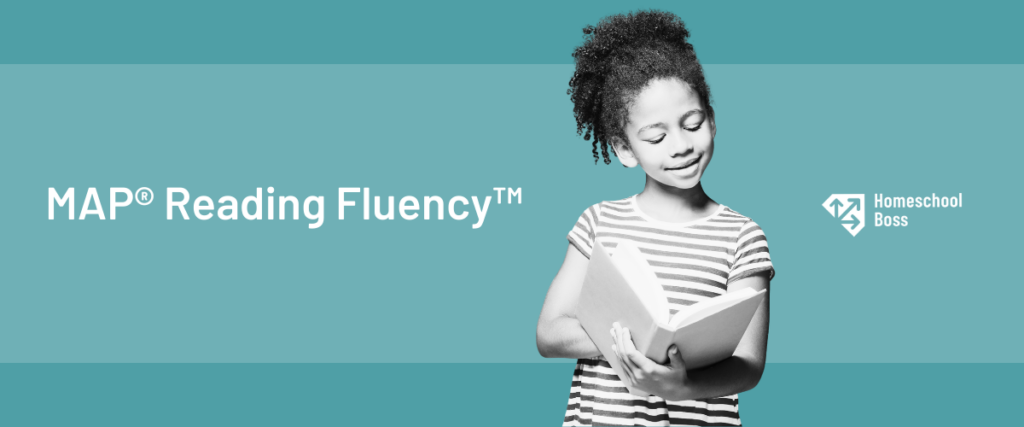
Homeschool Boss is adding the MAP Reading Fluency test for grade levels Pre-K-5 to our selection of test options! That gives you an additional choice when planning testing for your students. Here’s some helpful information to guide your decision making. And as always, feel free to call us or email us at sales@homeschoolboss.com with any questions.
What is reading fluency?
A child who reads fluently reads accurately at an appropriate speed, with proper expression that shows they understand what they are reading. Children who have yet to develop fluency when reading aloud still sound slow and awkward, and they may not show understanding of what they are reading. Children who are less fluent when reading silently may get stuck and quit or lose their place easily.
A little struggle with fluency is normal for early readers! But when a child struggles for a long time without improving fluency, their frustration can get in the way of learning. When parents and teachers have insight into why a child is having difficulties, they can find strategies to address that specific problem. A child reading with advanced fluency may enjoy reading more if they have texts matching their skills.
What does the MAP Reading Fluency test measure?
MAP Reading Fluency assesses four areas related to fluency- as an adaptive test, readers and pre-readers will be assessed for different skills.
Pre-readers will be assessed in:
- Foundational reading skills
- Phonological Awareness- Noticing the sounds that make up spoken words, blending sounds to make words, and segmenting words into sounds.
- Phonics/Word Recognition- Connecting letters to sounds and written words to spoken words.
- Language Comprehension- Understanding words, sentences and groups of sentences in spoken or written language.
- Dyslexia screening (grades K-3 only)
- Flags students who are on track to be in the bottom 10% of their grade level for reading skills.
- Rapid Automatized Naming (RAN)- Measures the student’s ability to quickly say the names of objects they recognize. People with slower RAN speeds often struggle with reading.
Readers will be assessed in:
- Oral reading fluency: reading aloud that shows an understanding of the passage
- Literal comprehension: understanding basic facts directly stated in the passage
How long does the MAP Reading Fluency test take?
The benchmarking test—taken once per test season—lasts about 20 minutes. Progress monitoring tests can be repeated throughout the year; these take 5-10 minutes, depending on the skills tested.
How is the MAP Reading Fluency test administered?
MAP Reading Fluency is an adaptive test, meaning that the questions adjust to the level of the student. Every test begins with a pre-test that guides a child to their appropriate level, whether that is foundational (pre-reading) skills or reading actual text aloud. The test is designed to let students log in and interact with it independently through a mouse and headset equipped with a microphone. Animation and bright graphics make it feel more like a game than a test for many students.
How often should I administer the MAP Reading Fluency Progress Monitoring test?
To be determined.
How does the MAP Reading Fluency test differ from the reading portion of the MAP Growth test?
MAP Reading Fluency and MAP Growth Reading are complementary tests, meaning they can be taken at the same time to get a fuller picture of a child’s performance and progress in literacy. Teachers and parents can also choose one test or the other.
MAP Reading Fluency focuses on fluency, and MAP Growth Reading focuses on text comprehension. For a pre-reader, comprehension skills include recognizing words and punctuation, identifying the main ideas of a story when read aloud, or learning new vocabulary words. Fluency skills include decoding words or letter combinations. Both tests include phonics, but MAP Growth Reading does not use phonics questions to assess fluency.
MAP Reading Fluency focuses on foundational skills usually attained by grade 5, while Map Growth Reading assesses comprehension and vocabulary skills through grade 12.
What is the MAP Reading Fluency Dyslexia Screener?
The Dyslexia Screener is based on the MAP Reading Fluency benchmark test. Students take a foundational skills assessment and a Rapid Automated Naming (RAN) measure. RAN asks students to name familiar objects and symbols, with no reading required. RAN is not based on literacy skills; it is a cognitive screening measure highlighting possible processing speed or memory difficulties that may impact reading fluency.
MAP Reading Fluency focuses on fluency, and MAP Growth Reading focuses on text comprehension. For a pre-reader, comprehension skills include recognizing words and punctuation, identifying the main ideas of a story when read aloud, or learning new vocabulary words. Fluency skills include decoding words or letter combinations. Both tests include phonics, but MAP Growth Reading does not use phonics questions to assess fluency.
MAP Reading Fluency focuses on foundational skills usually attained by grade 5, while Map Growth Reading assesses comprehension and vocabulary skills through grade 12.
How can I use MAP Reading Fluency test results with my students?
Test results from MAP Reading Fluency can help you better understand where a child is on their individual learning path. You might learn that a child has mastered something fully and is ready to move on, or you might discover that they don’t understand something as well as you thought. How you respond depends on you, the student, and your education philosophy. These lists from NWEA and Scholastic Publishing have suggestions you can use regardless of the curriculum you use, or even if you don’t use any curriculum at all.